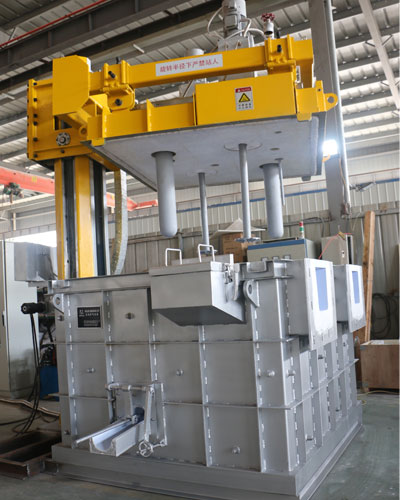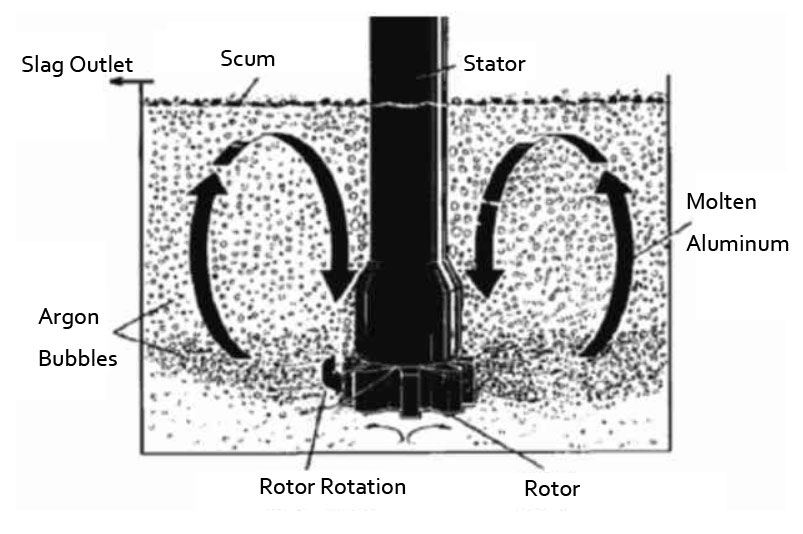Rotating Degassing method is currently the most widely used method of degassing and purifying molten aluminum. The principle of rotating degassing is to pass an inert gas or an active gas insoluble in the molten aluminum, or add a chlorine salt (chloride) to react with the molten aluminum to generate a gas, which generates a large number of escaped bubbles in the molten aluminum.
The hydrogen atoms dissolved in the molten aluminum migrate to the surface of the purification bubbles, are adsorbed on the surface of the bubbles, form hydrides into the hydrogen bubbles, and finally escape the kinetic process of the molten aluminum as the bubbles rise to complete the degassing and purification of the molten aluminum. This is a process in which hydrogen diffuses in the liquid phase and is adsorbed by bubbles.
The traditional bubble floatation method of degassing purification technology, such as single tube blowing method and multi-hole blowing head method can only meet certain conditions, and it is difficult to meet the above requirements at the same time. Although the multi-hole blow head method can produce smaller bubbles than the single-tube blow method, it does not improve much. Because the bubbles rise vertically during degassing in these two methods, if the air supply is increased, the liquid surface directly above the nozzle will be obviously raised by the effect of the bubble rise, causing the molten aluminum to churn and splash. Therefore, they cannot play the role of the main factor of air flow.

At present, the principle of a rotating nozzle, which has been paid more and more attention by people, satisfies the degassing dynamic conditions of bubble floatation method. The difference between it and the previous purification is that the purification gas is introduced from the shaft hole or the gap between the shaft and the sleeve, and is broken when flowing through the lower rotating nozzle blade and sprayed out at high speed. Then, the rotating molten aluminum rises to the liquid level.
The rotating nozzle method can give full play to the advantages of the bubble floatation method for hydrogen removal. The key is that the liquid forms a stream under the strong action of the nozzle, and the bubble is uniformly dispersed in the broken well under the action of the nozzle and the stream.
When the rotation speed is small, the shear stress of the bubbles is smaller, and the bubbles are larger, which is in the shape of a straw hat. When the rotation speed is high, the shear stress of the bubbles becomes larger, the volume of the bubbles is obviously reduced, and the bubble is distributed in a spherical shape. The number of bubbles increases, so the surface area of the bubbles in contact with the molten aluminum increases, which significantly improves the degassing dynamics.

The bubble is broken by the action of the liquid ejected from the blade, and moves away from the nozzle at the same time. Its displacement is related to the speed and the shape of the blade. When the speed is high, the head becomes larger accordingly. The longer the radial movement of the bubble becomes, the more diffuse the bubble distribution becomes. When the rotation speed is low, the bubbles gather near the nozzle, which increases the tendency of the bubbles. When the rotation speed is high, the bubbles diffuse. The distribution is more uniform. As the speed increases, the scope of the action of the liquid ejected from the blades is expanded, so that the bubble breaking process can be continued.
The structure of the rotating nozzle is the most important factor in the purification process of aluminum liquid. Its structure and design parameters are different, and the degree of stirring of the liquid is also different, and the size and number of bubbles generated will be different, which directly affects the effect of hydrogen removal. Different rotating nozzles have different apparent mass transfer coefficients under the same speed and gas flow.

